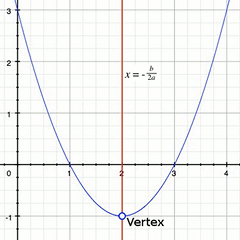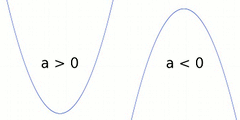Quadratic Equations
See also: numbers
A quadratic equation is a second degree polynomial equation. It has the general form:
The calculator below will calculate the Discriminant () and find the solutions (roots) of a quadratic equation.
Quadratic Equation Calculator
Enter the values of the coefficients a, b, and c.
Please report any error to [email protected]
Properties of a quadratic equation:
-
 The graph of a quadratic equation is called a parabola.
The graph of a quadratic equation is called a parabola.
- The axis of symmetry of the parabola is the line .
- The coordinate of the vertex of the parabola is found by evaluating at the axis of symmetry, i.e. evaluating at .
- If (i.e. positive), the parabola of the equation will face (open) up.
If (i.e. negative), the parabola of the equation will face (open) down.

- The value of
is called the Discriminant () of the quadratic equation.
By looking at the value of the discriminant of a quadratic equation, we can know the following:
- If the discriminant is positive (), the quadratic equation has 2 distinct roots and both are real numbers. The parabola of the quadratic equation intercepts the x-axis at two points.
- If the discriminant is equal to zero (), the quadratic equation has 1 root and it is a real number. The parabola of the quadratic equation intercepts the x-axis at exactly one point.
- If the discriminant is negative (), the quadratic equation has 2 distinct roots and both are complex numbers. The parabola of the quadratic equation does not intercept the x-axis.

Methods to solve or find the roots of a quadratic equation
There are a few methods to solve a quadratic equation, other than using the calculator above. The following are some of them.
- Factorization
- Completing the square
- Formula
See also: numbers